
The Scottish Rite Cathedral in Indianapolis, Indiana is a historic building designed by architect George F. Schreiber and located in downtown Indianapolis. It is owned by the Valley of Indianapolis Scottish Rite, an affiliated body of Freemasonry. It was built between 1927 and 1929 at the cost of $2.5 million. The cathedral is one of the largest Masonic buildings in the world and the largest Scottish Rite building anywhere. It has been described as one of the finest examples of Neo-Gothic architecture in the United States.

St. Bartholomew's Episcopal Church is a historic church building located on Vermont Route 118 in Montgomery, Vermont in the United States. Its congregation was formed in 1821 as Union Episcopal Church. Church construction began in 1833 and was completed in 1835, when it was consecrated by the Rt. Rev. John Henry Hopkins, first bishop of the Episcopal Diocese of Vermont. In 1897 its name was changed to St. Bartholomew's Episcopal Church.
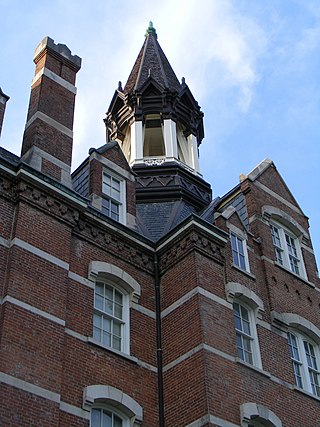
Jubilee Hall is the oldest academic building on the campus of Fisk University in Nashville, Tennessee, United States. Completed in 1876, it was the university's first permanent building, and is a good local example of Gothic Revival architecture. It was designated a National Historic Landmark in 1974, in recognition of the university's place as one of the first historically black colleges and universities to be established after the American Civil War. It presently serves as an undergraduate residence hall. In 2017 the Tennessee Historical Commission installed a marker honoring the Fisk Jubilee Singers, whose 1870s European tour raised the funds to pay for the building's construction.
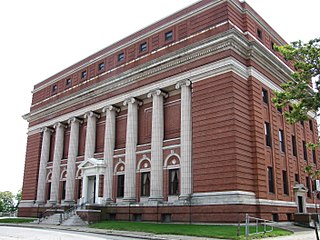
The Worcester Masonic Temple is a historic Masonic temple Located at 1 Ionic Avenue in downtown Worcester, Massachusetts. Construction on the temple began on September 12, 1913, with the laying of the cornerstone. The building was finished and dedicated on September 3, 1914, by the then Grand Master, Most Worshipful Melvin M. Johnson.

The Warsaw Courthouse Square Historic District is a historic district in Warsaw, Indiana that was listed on the National Register of Historic Places in 1982. Its boundaries were increased in 1993.
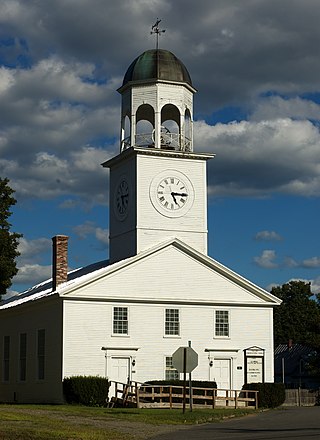
The Union Church, now Phillips Congregational Church, is a historic church on Main and Pleasant Streets in Phillips, Maine. Built in 1835, this Greek Revival church is the oldest religious building in the small community, and a distinctive local landmark. It was listed on the National Register of Historic Places in 1989.

The Swanton Christian Church, formerly the First Congregational Church of Swanton, Old Brick Meetinghouse, and New Wine Christian Fellowship is a historic church in the village of Swanton, Vermont. Built in 1823 and remodeled in 1869, it is a prominent landmark in the village, and a fine local example of Italianate styling on a Federal period building. It was listed on the National Register of Historic Places in 2001.

Gethsemane Lutheran Church is a historic Lutheran church in downtown Austin, Texas. It is designated as a Recorded Texas Historic Landmark and is listed on the National Register of Historic Places along with the neighboring Luther Hall. The building currently houses the offices of the Texas Historical Commission.
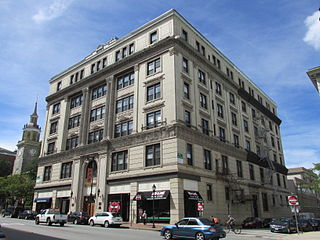
The Masonic Temple is a historic commercial and fraternal society building at 415 Congress Street in downtown Portland, Maine. Built in 1911 to a design by local architect Frederick A. Tompson, it is one of the city's finest examples of Beaux Arts architecture, and houses some of the state's grandest interior spaces. It was listed on the National Register of Historic Places in 1982.
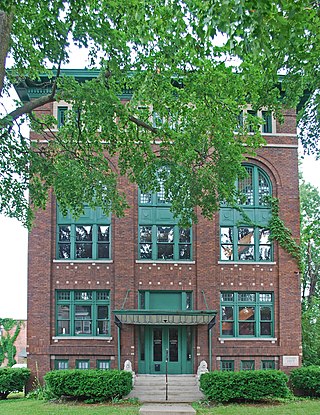
The Masonic Temple Building in Marshall, Michigan is a building from 1913. It was listed on the National Register of Historic Places in 1988. Today it houses Dance Dynamics and Engelter Photography.

The Masonic and Town Hall, located at 20 North Ridge Street in Port Sanilac, Michigan, was constructed as a Masonic Lodge constructed in 1884. It was listed on the National Register of Historic Places in 1996. Currently, no Masonic lodge meets in the building
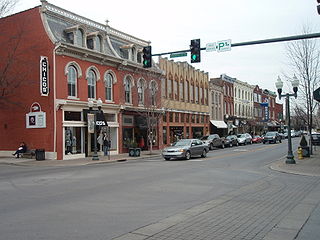
Franklin Historic District is a historic district in Franklin, Tennessee that was listed on the National Register of Historic Places in 1972. It was created to preserve historic commercial and residential architecture in a 16-block area of the original, downtown Franklin around the north, west, and south of the town square.

The Maine Woods Office, now the Phillips Community Building, is a historic commercial and community building on Main Street in Phillips, Maine. Built in 1848 by a local lawyer, it is regionally significant as a rare example of commercial Gothic Revival architecture, and as the original home of the Maine Woods newspaper, which disseminated news about sporting and hunting in Maine to an international audience. The building was listed on the National Register of Historic Places in 1980.
Harmony Hall is a historic religious and civic building at 24 Kennebec Road in Hampden, Maine. Built in 1829 as a Universalist church and restyled in 1896, it is a fine example of Greek Revival and Gothic Revival architecture, with a long history as a site for community events. It was listed on the National Register of Historic Places in 2007.
The Saratoga Masonic Hall is a two-story brick building in downtown Saratoga, Wyoming that houses Saratoga's Masonic lodge. Established in 1892, the lodge was the fourteenth to be established in Wyoming. After a time in rented space, the lodge bought the Couzens and Company Block in 1893, using the second floor for meetings and leasing the ground floor to storekeeper A. Johnson Dogget. From 1895 the ground floor was used as a school. The Masons allowed a variety of other organizations to use the building, including the Odd Fellows, Knights of Pythias, Pythian Sisters, Union Fraternal League, Modern Woodmen, Women of Woodcraft, Job's Daughters, the Republican Party and the Ku Klux Klan.

The First Lutheran Church of the Reformation is a historic church at 77 Franklin Square in New Britain, Connecticut. The congregation was founded in 1885 and the current church building was constructed 1903-07. The building, a fine local example of Late Gothic Revival architecture, was added to the National Register of Historic Places in 2010.

The Downtown Paris Historic District, in Paris, Kentucky, in Bourbon County, Kentucky, is a historic district which was listed on the National Register of Historic Places in 1989.

















